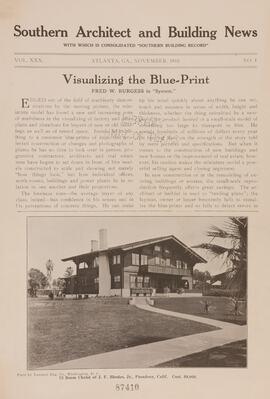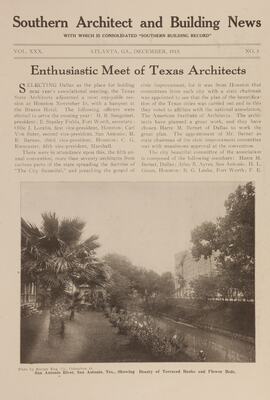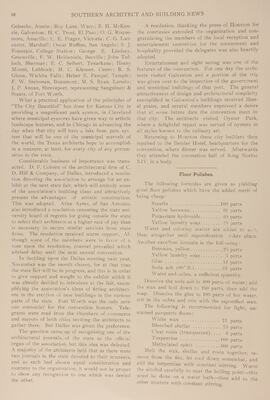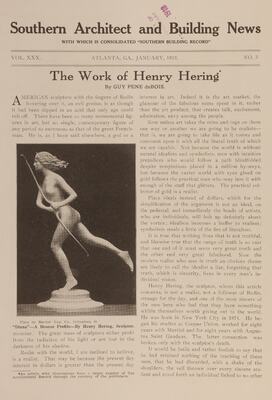Pages That Mention Southern Architect and Building News
1912-11 Southern Architect and Building News 30, no. 1
1
This page is not corrected, please help correct this page
1912-12 Southern Architect and Building News 30, no. 2
1
Southern Architect and Building News WITH WHICH IS CONSOLIDATED “SOUTHERN BUILDING RECORD” VOL. XXX. ATLANTA, GA., DECEMBER, 1912. NO. 2 Enthusiastic Meet of Texas Architects SELECTING Dallas as the place for holding next year’s associational meeting, the Texas State Architects adjourned a most enjoyable session at Houston November If, with a banquet at the Brazos Hotel. The following officers were elected to serve the ensuing year: M. R. Sanguinet, president; E. Stanley Fields, Fort Worth, secretary; Ollie J. Lorehn, first vice-president, Houston; Carl Von Suter, second vice-president, San Antonio; M. R. Barnes, third vice-president, Houston; C. G. Riencaster, fifth vice-president, Marshall. There were in attendance upon this, the fifth annual convention, more than seventy architects from various parts of the state spreading the doctrine of “The City Beautiful,” and preaching the gospel of civic improvement, for it was from Houston that committees from each city with a state chairman was appointed to see that the plan of the beautification of the Texas cities was carried out and in this they voted to affiliate with the national association, The American Institute of Architects. The architects have planned a great work, and they have chosen Harre M. Bernet of Dallas to work the great plan. The appointment of Mr. Bernet as state chairman of the civic improvement committee met with unanimous approval at the convention. The city beautiful committee of the association is composed of the following members: Harre M. Bernet, Dallas; Atlee B. Ayres, San Antonio; H. L. Green, Houston; B. G. Leake, Fort Worth; F. E. Plate bv Bucher Eng. Co.. Columbus, O. San Antonio River, San Antonio, Tex., Showing Beauty of Terraced Banks and Flower Beds.
2
16 SOUTHERN ARCHITECT AND BUILDING NEWS
Geisecke, Austin; Roy Lane, Waco; B. H. McKenzie, Galveston; H. C. Trost, El Paso; O. G. Roquemore, Amarillo; C. E. Prager, Victoria; C. G. Lancaster, Marshall; Oscar Ruffine, San Angelo; S. J. Fountain, College Station; George E. Lindsey, Greenville; F. W. Heldenfels, Beeville; John Tulloch, Sherman; E. C. Seibert, Texarkana; Henry Mount, Lubbock; M. C. Kleuser, Cuero; R. S. Glenn, Wichita Falls; Heber E. Pampel, Temple; F. W. Steinman, Beaumont; M. S. Ryan, Laredo; J. P. Annan, Shreveport, representing Sanguinett & Staats, of Fort Worth. What a practical application of the principles of “The City Beautiful” has done for Kansas City in providing a magnificent park system, in Cleveland where municipal eyesoreshave given way to artistic landscape features, and in Chicago, in advancing the day when that city will have a lake front park sys tem that will be one of the municipal marvels of the world, the Texas architects hope to accomplish in a measure, at least, forevery city ofany pretensions in the state. Considerable business of importance was transacted. D. F. Coburn of the architectural firm of C. D. Hill & Company, of Dallas, introduced a resolution directing the association to arrange for an exhibit at the next state fair, which will embody some of the association's building ideas and attractively present the advantages of artistic construction. This was adopted. Atlee Ayres, of San Antonio, also introduced a resolution censuring the state university board of regents for going outside the state to select their architects at a higher rate of pay than is necessary to secure similar services from state firms. The resolution received warm support. Although some of the members were in favor of a vote upon the resolution, counsel prevailed which advised delay until the next annual convention. In deciding upon the Dallas meeting next year, November was the month chosen, for at that time the state fair will be in progress, and this is in order to give support and weight to the exhibit which it was already decided to introduce at the fair, exemplifying the association’s ideas of fitting architecture in the erection of new buildings in the various parts of the state. Fort Worth was the only serious contender for the convention honors. Telegrams were read from the chambers of •commerce and mayors of both cities inviting the architects to gather there. But Dallas was given the preference. The question came up of recognizing one of the architectural journals of the state as the official organ of the association, but this idea was defeated. A majority of the architects held that as there were two journals in the state devoted to their interests, and as each had shown equal consideration and courtesy to the organization, it would not be proper to show any recognition to one which was denied the other. A resolution, thanking the press of Houston for the courtesies extended the organization and congratulating the members of the local reception and entertainment committee for the amusement and hospitality provided the delegates was also heartily adopted. Entertainment and sight seeing was one of the features of the convention. For one day the architects visited Galveston and a portion of the trip was given over to the inspection of the government and municipal buildings of that port. The general attractiveness of design and architectural simplicity exemplified in Galveston’s buildings received liberal praise, and several members expressed a desire that at some future date the convention meet in that city. The architects visited Oyster Park, where a delightful repast was served of oysters in all styles known to the culinary art. Returning to Houston these city builders then repaired to the Bender Hotel, headquarters for the convention, where dinner was served. Afterwards they attended the coronation ball of King Nottoc XIV, in a body.
Floor Polishes. The following formulas are given as yielding good floor polishes which have the added merit of being cheap: Stearin . . . . . . . . . . . . . . . . . . 100 parts Yellow beeswax. . . . . . . . . . . 25 parts Potassium hydroxide. . . . . . . . 60 parts Yellow laundry soap. . . . . . . . 10 parts Water and coloring matter are added to suit. Heat altogether until saponification lakes place Another excellent formula is th e foil a wing: Beeswax, yellow . . . . . . . . . . . 25 parts Yellow laundry soap. . . . . . . . . 6 parts Glue . . . . . . . . . . . . . . . . . . . . . . 12 parts Soda ash (80° B.) . . . . . . . . . . . . 25 parts Water and ochre, a sufficient quantity. Dissolve the soda ash in 4OO parts of water; add the wax and boil down to 250 parts, then add the soap. Dissolve the glue in 100 parts of hot water, stir in the ochre and mix with the saponified wax. The following is recommended for light, unstained parquette floors: White wax . . . . . . . . . . . . . . . . . 75 parts Bleached shellac . . . . . . . . . . . . 75 parts Clear rosin (transparent). . . . . . 6 parts Turpentine . . . . . . . . . . . . . . . . . 100 parts Methylated spirit . . . . . . . . . . . . 400 parts Melt the wax, shellac and rosin together, remove from the fire, let cool down somewhat, and add the turpentine with constant stirring. Warm the alcohol carefully to near the boiling point—this must be done on a water bath—then add to the other mixture with constant stirring.
1913-01 Southern Architect and Building News 30, no. 3
1
Southern Architect and Building News V WITH WHICH IS CONSOLIDATED “SOUTHERN BUILDING RECORD” VOL. XXX. ATLANTA, GA., JANUARY, 1913. NO. 3 The Whrk of Henry Hering By GUY PENE duBOIS AMERICAN sculpture with the fiugure of Rodin hovering over it, an evil genius, is as though it had been clipped in an acid that only age could rub off. There have been so many monumental figures in art, but no single, contemporary figure of any period so enormous as that of the great Frenchman. He is, as T have said elsewhere, a god or a monster. The great mass of sculptors either profit from the radiation of his light or are lost in the darkness of his shadow. Rodin with the world, I am inclined to believe, is a realist. That may be because the present day interest in dollars is greater than the present day ♦An article with illustrations from a recent number of The Architectural Record through the courtesy of the publishers. interest in art. Indeed it is the art market, the glamour of the fabulous sums spent in it, rather than the art product, that creates talk, excitement, admiration, envy among the people. Now unless art takes the reins and tugs on them one way or another we are going to be realists— that is, we are going to take life as it comes and comment upon it with all the literal truth of which we are capable. Not because the world is without natural idealists and symbolists, men with intuitive prejudices who would follow a path blindfolded despite temptations placed in a million by-ways, but because the vaster world with eyes glued on gold follows the practical man who may lure it with enough of the stuff that glitters. The practical collector of gold is a realist. Place ideals instead of dollars, which for the simplification of the argument is not an ideal, on the pedestal, and immediately the heads of artists, who are individuals, will bob up definitely above the vortex; idealism becomes a buffer to realism ; symbolism steals a little of the fire of literalism. It is true that nothing lives that is not truthful, and likewise true that the range of truth is so vast that one end of it must seem very great truth and the other end very great falsehood. Now the modern realist who sees in truth an obvious theme are likely to call the idealist a liar, forgetting that truth, which is sincerity, lives in every man’s individual vision. Henry Hering-, the sculptor, whom this article concerns, is not a realist, not a follower of Rodin, strange for the clay, and one of the most sincere of the men here who feel that they have something within themselves worth giving out to the world. He was 'born in New York City in 1874. He began his studies at Cooper Union, worked for eight years with Martini and for eight years with Augustus Saint Gaudens. The latter connection was broken only with the sculptor’s death. It would be futile and rather foolish to say that he had retained nothing of the teaching of these men, that he had discarded, with a shake of the shoulders, the veil thrown over every sincere student and stood forth an individual linked to no other Plate by Bucher Eng. Co., Columbus, O. “Diana”—A Bronze Profile—By Henry Hering, Sculptor.



